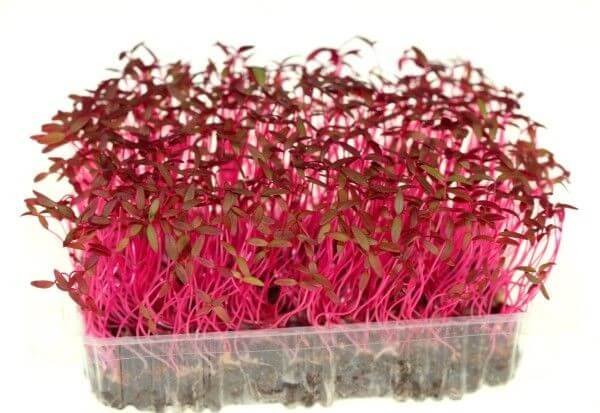There are approximately 70 species of the amaranth plant; you’ve probably come across the seed form of this food. But, have you ever considered eating, or even growing amaranth microgreens yourself?
They may not be the best-known microgreen, but they are an excellent choice. In fact, it is believed that the Aztecs actually consumed this plant as 80% of their diet!
You may be surprised to learn that these small plants are actually very high in both protein and fiber; this is why the Aztecs were able to survive on them and virtually nothing else.
Top Fact: Amaranth has almost 30% more protein than rice!

It’s worth noting that the usual approach is to grow beautiful red amaranth microgreens. However, it is possible to get leaves that are tinged green or even gold; all of them are delicious and surprisingly nutritious.
Amaranth Microgreens Health Benefits
There are a number of health benefits associated with amaranth microgreens:
- Gluten Free
Being gluten-free means this is a microgreen that can be enjoyed by virtually everyone. But, more important, is the fact that it can actually help to improve your digestive system. That’s a real benefit if you already have a sensitive system.
- Bone Health
There’s plenty of calcium in amaranth microgreens which helps to ensure you have strong teeth and bones. But amaranth microgreens have also been shown to help reduce the risk of osteoporosis; which is a major cause of issues as you age.
- Improves Immune System
The minerals, nutrients, and vitamins in amaranth microgreens will help to boost the strength of your immune system. This will help you fight off disease, including hypertension and cardiovascular issues.
It can also help to improve your recovery after you’ve been ill.
- Decreases Hair Loss
There are many products which can offer this benefit. In fact, this microgreen doesn’t just reduce hair loss, it also slows the graying process; allowing you to keep your natural hair color for longer.
- Weight Control
Another benefit associated with amaranth microgreens is that it is full of fiber. This will help you to feel full for longer, effectively reducing your appetite. In effect, it will help you to maintain or even lose weight.
How to Grow Amaranth Microgreens
Here’s your quick start guide re how to grow amaranth microgreens
- Soak: No, you can plant these straight away.
- Rinse/drain: No, amaranth likes to be misted but not soaked
- Time to germinate:2-3 days
- Time to harvest:10 – 15 days
Check out this Step by step growing amaranth microgreens guide:
Step 1 – Choose Your Growing Medium
To successfully grow amaranth microgreens you need to have a deep medium, 3-4 inches is a good starting point. This will give your roots room to grow and the soil will stay moist enough that you don’t need to water it too often.
You’ll need either a 10×20 tray or another container that suits the number of amaranth microgreens you’re hoping to grow. It will also be important to decide your preferred growing medium. A 50% soil and 50% coconut coir is a great option, although clay can also be a good way of keeping the plants moist without drowning them.
It can also be a good idea to make sure that your tray has drainage holes in it. You can then place a water tray under the growing tray, allowing the soil and plants to absorb water as they need it.
Step 2 – Preparing Your Seeds
It’s a good idea to use a seed shaker but you can do it by hand if you prefer. You’ll need to lightly cover the top of your growing medium. They should not be so dense that you can’t see any soil but you also don’t need to much soil still showing!
Step 3 – Germinating
Once you’ve planted the seeds slightly mist them with water. Don’t put too much on, you’ll increase the chances of mold growing.
You should then cover the tray with another tray; you don’t want the light to get in but a couple of ventilation holes on the sides will help to reduce the risk of mold growth.
For the next 2-3 days lightly mist the seeds once a day; you should see signs of germination by the end of this period.
Step 4 – Letting Them Grow
Once they have germinated you can leave the cover on for an extra 24 hours, this will help them grow a light pink color.
However, as soon as they reach ½ inch tall it’s time to remove the cover and transfer them to the light.
They don’t actually need direct sunlight, this is likely to kill them. During this time you should mist the plants daily or ensure there is always water in the tray below the growing media.
Once they hit 10 days old they should be ready to harvest!
FAQ
You’ll find answers to the most commonly asked questions below. If the answer you need isn’t there then contact me directly, I can help!
How long do amaranth microgreens take to grow
The whole process takes between 10 and 15 days. You don’t need a lot of time to monitor them on a daily basis.
It is worth noting that you can allow them to grow for longer than this, there is no upper limit as they will simply start to grow into full sized plants. Let your taste buds decide the optimum number of days for your amaranth microgreens to grow.
How to eat amaranth microgreens
It’s best to treat the amaranth microgreens as a tasty addition to your salad or in your sandwich.
However, you can also use them as a garnish on virtually any dish, boosting the nutritional value of your food. It is best to keep them raw, cooking them will diminish their nutritional value.
How to harvest amaranth microgreens
Once your amaranth microgreens appear to be ready use a sharp knife or scissors and cut the stems just above the soil line. This will prevent the soil from contaminating your plants; ensuring they don’t need to be washed.
Washing them can damage them as they are very delicate at this age.
How to store amaranth microgreens
It is best to avoid watering them for up to 12 hours before you harvest them. This will reduce the amount of water sitting on the leaves; which helps to prevent mod growing while you store them.
You can remove any excess water by placing them between two paper towels.
Once dry, simply place them into a plastic bag or container and store them in your refrigerator. They will only last 5-7 days and do taste better fresh. You may prefer to harvest them when you want to eat them.
What do amaranth microgreens taste like?
The best way to describe the taste is similar to spinach, although the flavor is deeper and surprisingly tender.
The colorful amaranth microgreens will enhance the flavor of your food while giving you an array of health benefits.

Sir,
It’s really a very good narrative for someone who wants to start Microgreens cultivation.
Thank you for your great help.
Raju Jacob,
Kerala, South India.
Thank you Kerala!
Whats your seed weight (dry) for the 1122 (1020) trays. im just starting out and didnt know if it was in your book? im in the uk also (not that that changes anythign)
The general consensus is 28 grams per 10×20 tray. Hope it helps!